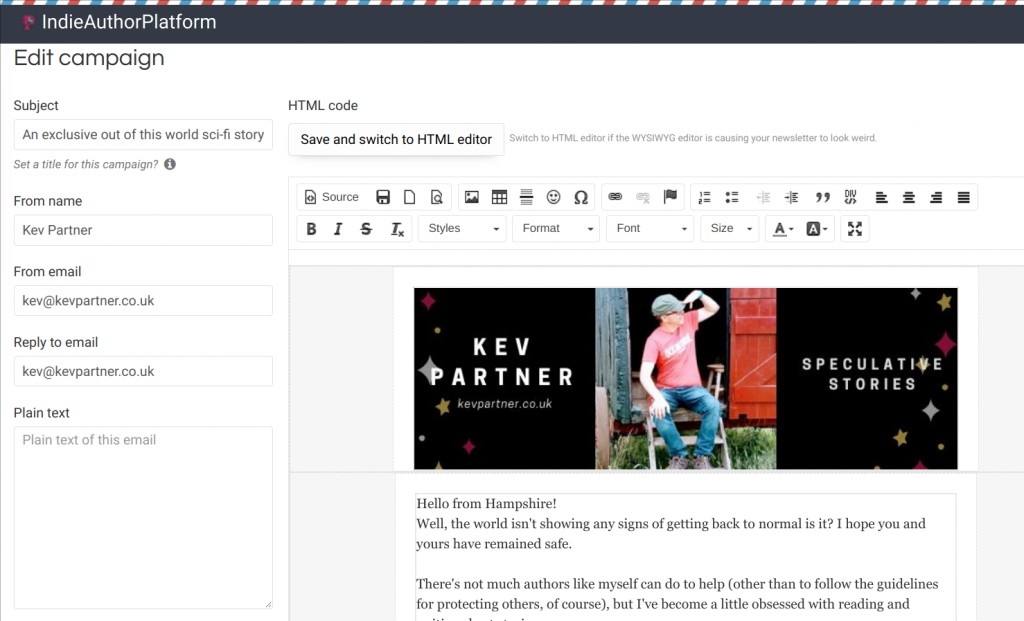I’ve bored my wife rigid this week. To cut a long story short (because I don’t want to bore you, too), I’d decided to scratch an itch that had been bothering me for some time. I’ve been using an email marketing service called Mailerlite for over two years and have, overall, been happy with it, but I don’t believe in simply accepting that what I have been doing is what I should continue to do, so I decided to set up a test.
I’m not going to go into any detail at this stage because that’s not the point of this article (though I will publish my results in time), but I decided to compare Mailterlite with two other services: Sendy and SendFox. I chose them because I wanted to focus on which of the three gets most successfully into the inboxes of subscribers–surely the primary purpose of any email service? I didn’t compare ML with Mailchimp or ConvertKit because they work in the same way it does: they send the emails from their own servers. Sendy, however, uses Amazon’s email service and SendFox uses one called SendGrid.
Anyway. I split my subscriber list into three, and constructed an identical email for each service so I was comparing like with like. In doing that, I noticed how much more sophisticated MailerLite is when it comes to allowing me to design my email than Sendy or, especially, SendFox. In the end, I went with the lowest common denominator and, therefore, a simple email design.
To begin with, this was torture. I’m very familiar with ML, and it seemed that the other two were crude by comparison. I almost gave up the experiment: after all, what is the point in knowing that one of the others is more effective at delivering emails if they are so basic as to be unusable.
But then, as I got more familiar with them, I realised that I began to enjoy their simplicity. By restricting my range of options (not just in creating emails but in every aspect of using them), they actually became easier to use. In other words, MailerLite was necessarily helping me by including so many features.
It is possible, I pondered, that one reason I’ve struggled to be consistent with my email newsletters is that the process is too complex. Would I send more emails if it were just a matter of writing the message and hitting send?
The answer’s a little more subtle than that. There is a minimal level of functionality I require. SendFox is below that minimal. Its email editor is too primitive and buggy to be a candidate. Sendy, on the other hand, has just enough. I think. I intend to find out over the next couple of months and then make a decision.

How does this relate to writing? Well, as I was mulling this over, I came to realise that I do seek out simplicity in other areas of life. I don’t use Word or Scrivener for writing my first drafts (for various reasons, but feature-bloat is one) and I don’t write on an expensive, complex computer. These says, I write using Dabble (previously I wrote over a million words in Novlr). Dabble has far fewer features than Word or Scrivener, but it has enough. And at no point is my writing hindered by having to work it out.
I use a Chromebook to write my first drafts. About as simple as a computer can be, Chromebooks are essentially browser-based. My Chrome bookmarks from my desktop PC are reproduced automatically on my Chromebook and I can be writing seconds after flipping open the lid. The battery lasts a full ten hour day and updates take seconds. And Chromebooks are super-cheap compared to, say, a Macbook Air or Surface.
Some authors seek simplicity by using pen and paper. As with SendFox, that’s a step too far for me – I would find that exceptionally tedious. So, it’s a matter of finding your personal level.
The trick is to find the right level of technology so that it helps exactly as much as you need without becoming a burden or distraction. For email writing, Sendy may prove to be at that level or I might find myself frustrated enough to go back to Mailerlite. For first drafts, Dabble is my tool of choice because it allows me to focus entirely on the words while having the features I need available at the touch of a button.
When the procrastination demon is stalking the corridors of your mind, the fewer excuses you can give to distract you, the better. More features does not equal a better tool. If you have a nail to bang in, then all you need is a hammer.
